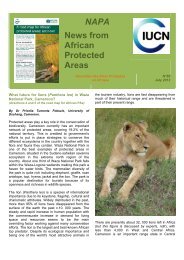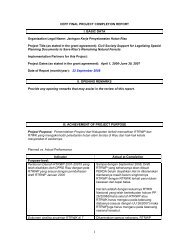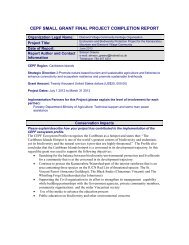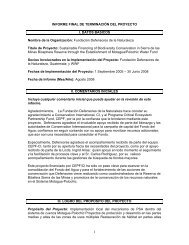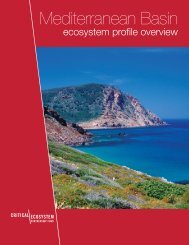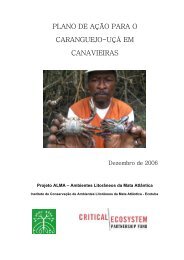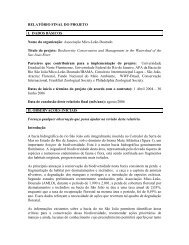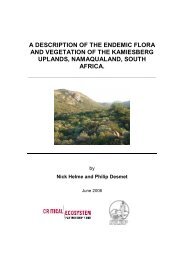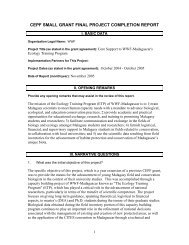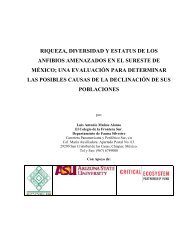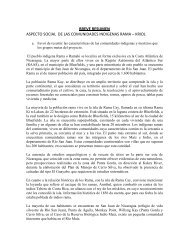2012 Vahatra Annual Report - Critical Ecosystem Partnership Fund
2012 Vahatra Annual Report - Critical Ecosystem Partnership Fund
2012 Vahatra Annual Report - Critical Ecosystem Partnership Fund
Create successful ePaper yourself
Turn your PDF publications into a flip-book with our unique Google optimized e-Paper software.
“biodiversity educators”, travel to rural villages to conduct biodiversity<br />
education programs.<br />
Using a traditional Malagasy system of public forums, the<br />
“biodiversity educators” travel to about 20 villages per year within a<br />
given region of the island to transfer different types of scientific and<br />
ecological information to local populations using a variety of media<br />
(talks, discussions, films, posters, tee shirts, etc.). These forums would<br />
provide a greater understanding of what scientific knowledge can offer<br />
in ameliorating their lives. Further, in villages with primary schools,<br />
considerable emphasis is placed on presenting clear and informative<br />
messages and lessons to school kids, who are the future of the nation.<br />
An evaluation mission of the project was carried-out by Voahangy<br />
and Achille at two of the targeted villages. The principal intent was to<br />
assess the perception of the program by local people. A very simple<br />
approach was adopted – the “Science for the people” team pursued their<br />
planned program and Voahangy and Achille attended as participants<br />
to evaluate if such meetings are effective in raising public interests.<br />
They do not intervene, just observed, to avoid influencing the behavior<br />
of the local participants. They observed that in the two different<br />
villages they attended meetings, a remarkable level of participation of<br />
people, comprised of different age groups representing three different<br />
generations of certain families, actively contributed to discussions. One<br />
student from a local public primary school even wrote and read a poem,<br />
inciting people to protect their unique natural heritage and inviting them<br />
to learn more about the biodiversity. Furthermore, local authorities, as<br />
well as members of the local communities, helped facilitate the “Science<br />
for the people” team activities and joined them during visits to the local<br />
forest.<br />
OTHER CAPACITY BUILDING PROGRAMS FOR MALAGASY<br />
STUDENTS AND RESEARCHERS<br />
Lecture series<br />
A lecture series has been organized at the <strong>Vahatra</strong> office to allow<br />
dissemination of new research, monitoring, and conservation themes<br />
concerning Madagascar. Another intent for the series is the exchange<br />
of ideas, both in a formal setting in the context of the lectures, and in<br />
a more informal setting of a cocktail after each lecture. To meet this<br />
goal individuals and organizations from the private, academic, and<br />
governmental sectors are invited to participate. A relatively large room at<br />
the <strong>Vahatra</strong> office, which normally serves as the students’ working space,<br />
is easily converted into a lecture hall, with folding chairs rented from<br />
a nearby restaurant. An attempt has been made to hold these lectures<br />
every 2-3 months, but with the political problems since the first portion<br />
of 2009, this was complicated to arrange. Lectures are attended by 40-80<br />
people and have been enthusiastically received by the Malagasy scientific<br />
and conservation communities.<br />
In <strong>2012</strong>, three conferences<br />
were presented:<br />
1. Génétique des populations,<br />
Conservation génétiques<br />
et application by Lounès<br />
Chikhi, Chargé de<br />
Recherche au Centre<br />
National de la Recherche<br />
Scientifique à l’Université<br />
Paul Sabatier de Toulouse<br />
(June <strong>2012</strong>).<br />
2. L’impact des espèces<br />
exotiques envahissantes<br />
sur la biodiversité insulaire<br />
- Quelles solutions ? by<br />
Olivier Langrand, Director<br />
of Global Affairs, Island<br />
Conservation, USA (July<br />
<strong>2012</strong>).<br />
3. Fenêtres sur les animaux<br />
extraordinaires et les<br />
écosystèmes récemment<br />
disparus de Madagascar<br />
by Steven M. Goodman,<br />
Association <strong>Vahatra</strong> and<br />
Field Museum (December<br />
<strong>2012</strong>).<br />
VAHATRA <strong>Annual</strong> report <strong>2012</strong> 15



